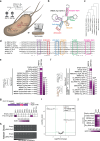Evasion of antiviral bacterial immunity by phage tRNAs
- PMID: 39528469
- PMCID: PMC11555353
- DOI: 10.1038/s41467-024-53789-y
Evasion of antiviral bacterial immunity by phage tRNAs
Abstract
Retrons are bacterial genetic elements that encode a reverse transcriptase and, in combination with toxic effector proteins, can serve as antiphage defense systems. However, the mechanisms of action of most retron effectors, and how phages evade retrons, are not well understood. Here, we show that some phages can evade retrons and other defense systems by producing specific tRNAs. We find that expression of retron-Eco7 effector proteins (PtuA and PtuB) leads to degradation of tRNATyr and abortive infection. The genomes of T5 phages that evade retron-Eco7 include a tRNA-rich region, including a highly expressed tRNATyr gene, which confers protection against retron-Eco7. Furthermore, we show that other phages (T1, T7) can use a similar strategy, expressing a tRNALys, to counteract a tRNA anticodon defense system (PrrC170).
© 2024. The Author(s).
Conflict of interest statement
Figures




References
Publication types
MeSH terms
Substances
Associated data
- Actions
- Actions
- Actions
Grants and funding
- JP23wm0325065/Japan Agency for Medical Research and Development (AMED)
- JP21fk0108496/Japan Agency for Medical Research and Development (AMED)
- JP21wm0325022/Japan Agency for Medical Research and Development (AMED)
- JP22fk0108532/Japan Agency for Medical Research and Development (AMED)
- JP24fk0108698/Japan Agency for Medical Research and Development (AMED)
- JP21gm1610002/Japan Agency for Medical Research and Development (AMED)
- JP22fk0108562/Japan Agency for Medical Research and Development (AMED)
- JP23fk0108599/Japan Agency for Medical Research and Development (AMED)
- 21H02110/MEXT | Japan Society for the Promotion of Science (JSPS)
- 21K19666/MEXT | Japan Society for the Promotion of Science (JSPS)
- 23K13876/MEXT | Japan Society for the Promotion of Science (JSPS)
- 22K20575/MEXT | Japan Society for the Promotion of Science (JSPS)
- 23K19475/MEXT | Japan Society for the Promotion of Science (JSPS)
LinkOut - more resources
Full Text Sources
Molecular Biology Databases

